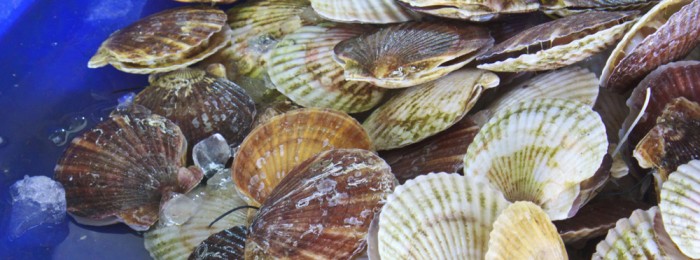01843 585310
info@kentandessex-ifca.gov.uk

01843 585310
info@kentandessex-ifca.gov.uk

Pectens maximus Scallops are an asymmetric bivalve with the top shell or valve appearing concave when juvenile and becoming flatter as they age while the bottom valve is rounded. Both shells have externally sculptured exteriors with up to 17 rounded ribs cross sectioned by clear growth rings. One growth ring per year is seen, indicating the reduction in active grown during winter months. The top, flat shell is usually deeply coloured brick red-brown while the bottom shell is usually a pale brown to dirty white. Adults are hermaphroditic and begin to spawn into the water column from around 3 years old.
Planktonic larvae stay in the water column until they have metamorphosed into miniature scallops (commonly referred to as spat until they are 1 year old) which are ready to settle and temporarily attach on suitable substrate material with its foot. Suitable settlement substrate often consists of complex high relief natural/living benthic structures such as hydrozoan colonies, maerl, kelps and the filaments of bushy seaweeds. Once spat have grown to between 4-13 mm they detach from the settlement site and move to appropriate substrate. Scallops are a filter feeder usually found with the bottom curved shell slightly berried into a substrate of fine sand and gravel from sub literal areas to over 100 m depth.
They are also able to swim short distances to avoid predation. Scallops like many bivalve species are an import part of the lower trophic levels in ecosystem food chains. As broadcast spawners and having planktonic larvae, early stage scallops form an important part of the zooplankton present in the water column from late spring into the summer months. Once metamorphosed into spat they begin to filter feed on phytoplankton and organic detritus in the water column. Common predators of adult scallops include starfish, cephlapods and large crabs. However, predators must be able to overpower the scallops strong adductor muscle which clamps the two bivalves tightly shut protecting the soft inner tissues. C
© Kent & Essex IFCA 2025 - All Rights Reserved | Privacy Policy